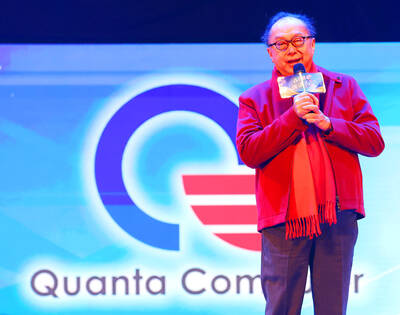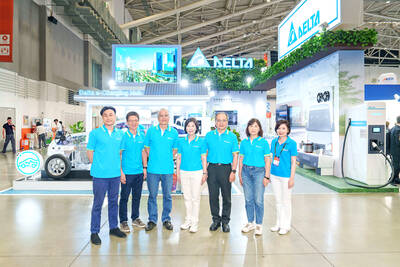After about 200 days of around-the-clock construction and NT$1 billion (US$30.3 million) later, the Taiwan pavilion at the World Expo 2010, which will be held in Shanghai next month, is ready to showcase the nation’s technological and cultural prowess to visitors from around the world.
The Taiwan pavilion is among the 16 pavilions that are scheduled to participate in a trial run next Tuesday, thanks to an earlier-than-expected completion of the project, said Wang Chih-kang (王志剛), chairman of the Taiwan External Trade Development Council (TAITRA, 外貿協會), which operates the pavilion.
“The pavilion will tell the world about the beauty of the natural scenery [in Taiwan] and our technological competitiveness,” Wang told a pre-expo press conference yesterday.
Taiwan last attended the World Expo in Osaka, Japan, in 1970, a year before losing its seat at the UN to China, and has been absent ever since, reflecting lingering political tensions with Beijing.
Shanghai extended an invitation to Taipei in May last year.
More than 190 countries are participating, with the expo running for six months. The contract was sealed in July after two months of discussions on official titles and location for the Taiwan pavilion, Wang said.
The pavilion is located in Zone A, a central position shared by Hong Kong, China, Macau, India, Japan and South Korea, among others.
Despite being the last pavilion to start construction in August, the Taiwan pavilion was completed ahead of schedule on March 31. It was the fifth-fastest completed pavilion among the 46 pavilions that chose to design and build their own pavilions rather than use ready-made pavilions offered by the organizer, TAITRA said.
More than 70 million visitors are expected to visit the World Expo, with 1 percent — or 800,000 people — expected to enter the Taiwan pavilion because of the size of the expo venue and limited space at the Taiwan booths, Wang said.
The Taiwan pavilion intends to stand out by using 4D technology, complete with light and audio effects to capture the attention of visitors from a distance, TAITRA said.
“The Taiwan pavilion can accommodate more than 4,300 visitors a day,” Wang said. “As long as each visitor spends 20 minutes enjoying the beauty of Taiwan, our mission will be accomplished.”
The pavilion design is a transparent cube housing a giant ball at the center. It is mainly made of steel and glass, with the outlines of Yushan and Alishan painted on the facade.
The main part of the pavilion was built with stone from Yushan and soil from Yingge Township (鶯歌), Taipei County. Visitors will also be invited to fly sky lanterns for good luck.
The pavilion showcases Taiwan’s scenery, kind-hearted people and culture with the theme of “Mountain, Water, Heart and Lantern,” TAITRA said.

Quanta Computer Inc (廣達) chairman Barry Lam (林百里) is expected to share his views about the artificial intelligence (AI) industry’s prospects during his speech at the company’s 37th anniversary ceremony, as AI servers have become a new growth engine for the equipment manufacturing service provider. Lam’s speech is much anticipated, as Quanta has risen as one of the world’s major AI server suppliers. The company reported a 30 percent year-on-year growth in consolidated revenue to NT$1.41 trillion (US$43.35 billion) last year, thanks to fast-growing demand for servers, especially those with AI capabilities. The company told investors in November last year that

Intel Corp has named Tasha Chuang (莊蓓瑜) to lead Intel Taiwan in a bid to reinforce relations between the company and its Taiwanese partners. The appointment of Chuang as general manager for Intel Taiwan takes effect on Thursday, the firm said in a statement yesterday. Chuang is to lead her team in Taiwan to pursue product development and sales growth in an effort to reinforce the company’s ties with its partners and clients, Intel said. Chuang was previously in charge of managing Intel’s ties with leading Taiwanese PC brand Asustek Computer Inc (華碩), which included helping Asustek strengthen its global businesses, the company

Taiwanese suppliers to Taiwan Semiconductor Manufacturing Co. (TSMC, 台積電) are expected to follow the contract chipmaker’s step to invest in the US, but their relocation may be seven to eight years away, Minister of Economic Affairs J.W. Kuo (郭智輝) said yesterday. When asked by opposition Chinese Nationalist Party (KMT) Legislator Niu Hsu-ting (牛煦庭) in the legislature about growing concerns that TSMC’s huge investments in the US will prompt its suppliers to follow suit, Kuo said based on the chipmaker’s current limited production volume, it is unlikely to lead its supply chain to go there for now. “Unless TSMC completes its planned six

Power supply and electronic components maker Delta Electronics Inc (台達電) yesterday said it plans to ship its new 1 megawatt charging systems for electric trucks and buses in the first half of next year at the earliest. The new charging piles, which deliver up to 1 megawatt of charging power, are designed for heavy-duty electric vehicles, and support a maximum current of 1,500 amperes and output of 1,250 volts, Delta said in a news release. “If everything goes smoothly, we could begin shipping those new charging systems as early as in the first half of next year,” a company official said. The new